UNIT 1
Fundamentals of Computers
TABLE OF CONTENTS
1.1 | Generations of computer |
1.2 | Block diagram of a computer |
1.3 | Computer hardware and software components: Central Processing Unit (CPU) |
1.4 | VDU |
1.5 | Keyboard and Mouse |
1.6 | Other input/output Devices |
1.7 | Computer Memory |
1.8 | Memory Hierarchy: Primary and Secondary Storage (Auxiliary Storage) |
1.9 | Secondary storage |
1.10 | Magnetic disks vs optical disks (CD, CD-RW and DVD Memory) |
1.11 | Data – numeric data |
1.12 | Alpha numeric data |
1.13 | Concept of data and information: Storage, Seeking |
1.14 | Processing and Transmission |
Generation in computer terminology is a change in technology a computer is/was being used. Initially, the generation term was used to distinguish between varying hardware technologies. Nowadays, generation includes both hardware and software, which together make up an entire computer system.
There are five computer generations known till date. Each generation has been discussed in detail along with their time period and characteristics. In the following table, approximate dates against each generation have been mentioned, which are normally accepted.
Following are the main five generations of computers.
First Generation
The period of first generation was from 1946-1959. The computers of first generation used vacuum tubes as the basic components for memory and circuitry for CPU (Central Processing Unit). These tubes, like electric bulbs, produced a lot of heat and the installations used to fuse frequently. Therefore, they were very expensive and only large organizations were able to afford it.
In this generation, mainly batch processing operating system was used. Punch cards, paper tape, and magnetic tape was used as input and output devices. The computers in this generation used machine code as the programming language.

The main features of the first generation are –
- Vacuum tube technology
- Unreliable
- Supported machine language only
- Very costly
- Generated a lot of heat
- Slow input and output devices
- Huge size
- Need of AC
- Non-portable
- Consumed a lot of electricity
Some computers of this generation were −
- ENIAC
- EDVAC
- UNIVAC
- IBM-701
- IBM-650
Second Generation
The period of second generation was from 1959-1965. In this generation, transistors were used that were cheaper, consumed less power, more compact in size, more reliable and faster than the first generation machines made of vacuum tubes. In this generation, magnetic cores were used as the primary memory and magnetic tape and magnetic disks as secondary storage devices.
In this generation, assembly language and high-level programming languages like FORTRAN, COBOL was used. The computers used batch processing and multiprogramming operating system.
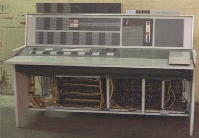
The main features of second generation are –
- Use of transistors
- Reliable in comparison to first generation computers
- Smaller size as compared to first generation computers
- Generated less heat as compared to first generation computers
- Consumed less electricity as compared to first generation computers
- Faster than first generation computers
- Still very costly
- AC required
- Supported machine and assembly languages
Some computers of this generation were −
- IBM 1620
- IBM 7094
- CDC 1604
- CDC 3600
- UNIVAC 1108
Third Generation
The period of third generation was from 1965-1971. The computers of third generation used Integrated Circuits (ICs) in place of transistors. A single IC has many transistors, resistors, and capacitors along with the associated circuitry.
The IC was invented by Jack Kilby. This development made computers smaller in size, reliable, and efficient. In this generation remote processing, time-sharing, multiprogramming operating system was used. High-level languages (FORTRAN-II TO IV, COBOL, PASCAL PL/1, BASIC, ALGOL-68 etc.) were used during this generation.
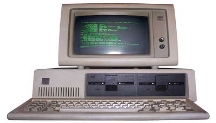
The main features of third generation are –
- IC used
- More reliable in comparison to previous two generations
- Smaller size
- Generated less heat
- Faster
- Lesser maintenance
- Costly
- AC required
- Consumed lesser electricity
- Supported high-level language
Some computers of this generation were −
- IBM-360 series
- Honeywell-6000 series
- PDP (Personal Data Processor)
- IBM-370/168
- TDC-316
Fourth Generation
The period of fourth generation was from 1971-1980. Computers of fourth generation used Very Large Scale Integrated (VLSI) circuits. VLSI circuits having about 5000 transistors and other circuit elements with their associated circuits on a single chip made it possible to have microcomputers of fourth generation.
Fourth generation computers became more powerful, compact, reliable, and affordable. As a result, it gave rise to Personal Computer (PC) revolution. In this generation, time sharing, real time networks, distributed operating system were used. All the high-level languages like C, C++, DBASE etc., were used in this generation.
The main features of fourth generation are –
- VLSI technology used
- Very cheap
- Portable and reliable
- Use of PCs
- Very small size
- Pipeline processing
- No AC required
- Concept of internet was introduced
- Great developments in the fields of networks
- Computers became easily available
Some computers of this generation were −
- DEC 10
- STAR 1000
- PDP 11
- CRAY-1(Super Computer)
- CRAY-X-MP(Super Computer)
Fifth Generation
The period of fifth generation is 1980-till date. In the fifth generation, VLSI technology became ULSI (Ultra Large Scale Integration) technology, resulting in the production of microprocessor chips having ten million electronic components.
This generation is based on parallel processing hardware and AI (Artificial Intelligence) software. AI is an emerging branch in computer science, which interprets the means and method of making computers think like human beings. All the high-level languages like C and C++, Java, .Net etc., are used in this generation.
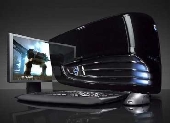
AI includes –
- Robotics
- Neural Networks
- Game Playing
- Development of expert systems to make decisions in real-life situations
- Natural language understanding and generation
The main features of fifth generation are −
- ULSI technology
- Development of true artificial intelligence
- Development of Natural language processing
- Advancement in Parallel Processing
- Advancement in Superconductor technology
- More user-friendly interfaces with multimedia features
- Availability of very powerful and compact computers at cheaper rates
Some computer types of this generation are −
- Desktop
- Laptop
- Notebook
- Ultrabook
- Chromebook
Computer Block Diagram
Mainly computer system consists of three parts that are central processing unit (CPU), Input Devices, and Output Devices. The Central Processing Unit (CPU) is divided into two parts again: arithmetic logic unit (ALU) and the control unit (CU). The set of instruction is in the form of raw data.
A large amount of data is stored in the computer memory with the help of primary and secondary storage devices. The CPU is like the heart/brain of the computer. The user does not get the desired output, without the necessary option taken by the CPU. The Central processing unit (CPU) is responsible for the processing of all the instructions which are given by the user to the computer system.
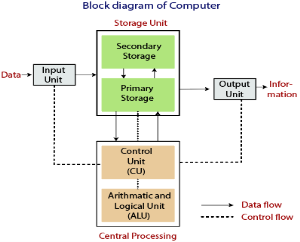
Fig: Block Diagram of the computer.
The data is entered through input devices such as the keyboard, mouse, etc. This set of instruction is processed by the CPU after getting the input by the user, and then the computer system produces the output. The computer can show the output with the help of output devices to the user, such as monitor, printer, etc.
- CPU (Central Processing Unit)
- Storage Unit
- ALU(Arithmetic Logic Unit)
- Control Unit
Central Processing Unit (CPU)
The computer system is nothing without the Central processing Unit so, it is also known as the brain or heat of computer. The CPU is an electronic hardware device which can perform different types of operations such as arithmetic and logical operation.
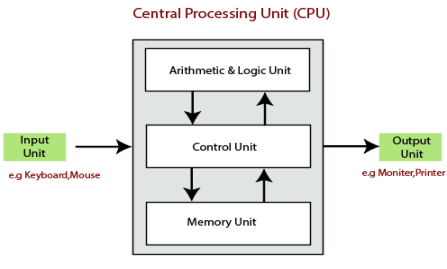
The CPU contains two parts: the arithmetic logic unit and control unit. We have discussed briefly the arithmetic unit, logical unit, and control unit which are given below:
Control Unit
The control unit (CU) controls all the activities or operations which are performed inside the computer system. It receives instructions or information directly from the main memory of the computer.
When the control unit receives an instruction set or information, it converts the instruction set to control signals then; these signals are sent to the central processor for further processing. The control unit understands which operation to execute, accurately, and in which order.
Arithmetic and Logical Unit
The arithmetic and logical unit is the combinational digital electronic circuit that can perform arithmetic operations on integer binary numbers.It presents the arithmetic and logical operation. The outputs of ALU will change asynchronously in response to the input. The basic arithmetic and bitwise logic functions are supported by ALU.
Storage Unit
The information or set of guidelines are stored in the storage unit of the computer system. The storage unit provides the space to store the data or instruction of processed data. The information or data is saved or hold in computer memory or storage device. The data storage is the core function and fundamental of the computer components.
Components of Computer System
The hardware and software exist on the computer. The information which is stored through the device is known as computer software. The hardware components of the computer system are related to electronic and mechanical parts, and the software component is related to data and computer programs. Many elements are connected to the main circuit board of the computer system called a “motherboard.”
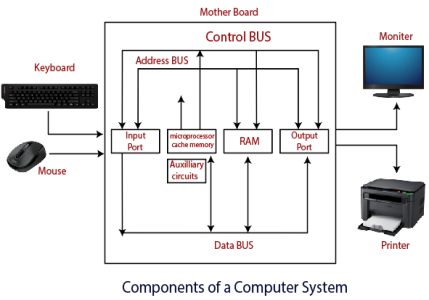
- Processor.
- Main Memory.
- Secondary Memory.
- Input Devices.
- Output Devices.
These are mainly five components of the computer system. The computer hardware, computer software, and liveware exist in the element of the computer system.
Processor
The processor is an electric circuitry within the computer system. The Central processing unit is the central processor or main processor of the computer system. The processor carries out the instructions of the computer program with the help of basic arithmetic and logic, input/output operations.
Main Memory
The Random Access Memory is the main memory of the computer system, which is known as RAM. The main memory can store the operating system software, application software, and other information. The Ram is one of the fastest memory, and it allows the data to be readable and writeable.
Secondary memory
We can store the data and programs on a long-term basis in the secondary memory. The hard disks and the optical disks are the common secondary devices. It is slow and cheap memory as compare to primary memory. This memory is not connected to the processor directly.
It has a large capacity to store the data. The hard disk has a capacity of 500 gigabytes. The data and programs on the hard disk are organized into files, and the file is the collection of data on the disk. The secondary storage is direct access by the CPU; that’s why it is different from the primary storage.
The hard disk is about 100 times the capacity of the main memory. The main difference between primary and secondary storage is speed and capacity. There are several large blocks of data which are copied from the hard disk into the main memory.
Input Devices
The user provides the set of instruction or information to the computer system with the help of input devices such as the keyboard, mouse, scanner, etc. The data representation to the computer system is in the form of binary language after that the processor processes the converted data. The input unit implements the data which is instructed by the user to the system.
We can enter the data from the outside world into the primary storage as the input through input devices. The input devices are the medium of communication between the outside world and the computer system. There are some important features of input devices which are given below:
- The input devices receive or accept the data or instruction from the user, who exist in the outside world.
- These devices convert the data or instruction into the machine-readable form for further processing.
- The input device performs like the connection between the outside world and our computer system.
- The keyboard and mouse are common examples of input devices.
- When the whole procedure is finished, we get the desired output from the output devices such as monitor, printer, etc.
Output Devices
The output devices produce or generate the desired result according to our input, such as a printer, monitor, etc. These devices convert the data into a human-readable form from binary code.
The computer system is linked or connected to the outside world with the help of output devices. The primary examples of output devices are a printer, projector, etc. These devices have various features which are given below:
- These devices receive or accept the data in the binary form.
- The output devices convert the binary code into the human-readable form.
- These devices produce the converted result and show to the user.
What is a CPU in Computer System? :: The CPU stands for Central Processing Unit and additionally called a Microprocessor or Microchip. Now the CPU or microprocessor is the essential and fundamental part of computer system, where all the arithmetic and logical calculation takes place. It interprets, translates, and carries out the instructions for operating a computer as a device.
In other words, the set of instructions or data are introduced to the PC system in form of raw data through input devices of computer, and later this instruction are processed or prepared to get desired or wanted result.
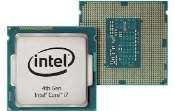
Central Processing Unit [Microprocessor]
Now as we talk or discuss CPU’s or Microprocessor we tend to talk about their speed, accuracy, and reliability, as the significant computer technology development the speed of CPU’s has changed dramatically. Most processors nowadays are multicore processors. A multi-core processor is a single chip with at least two or more separate processor core, or layers which has the circuitry to process instructions and directions.
Every PC contains no less than one processor yet you can see many computers with multiple processors, this processor executes each instruction and directions separately.
The processor or CPU are installed on motherboard or mainboard they are typically square shaped with more than 250 pins on the base surface of the chip, the processor is connected or associated with the motherboard by a Zero insertion force (ZIF).To avoid from overheating heat sink and CPU fan is installed on processors.
Common multicore processor are ::
- Dual- Core Processor is a processor which contains two separate cores of processors
- Triple core processor contains three separate cores of processors
- Quad-Core processor contains four separate cores of processors
- The CPU is also considered as a brain of computer
- Famous manufacturers of processor are Intel and AMD
Components of CPU [Central Processing Unit ]
The main or fundamental components of CPUs are Arithmetic logic unit, Control unit and Cache Memory.
Arithmetic and logic unit:
ALU perform all the arithmetic and logic calculation provided to computer systems that are addition, subtraction, multiplication, division, comparison, greater, less.
Control Unit:
This unit controls and facilitates all the activities and operations performed in the PC system. It gets programs from the main memory of the computer system to interpret or translate them and control other units to get the desired result.
Cache:
Cache memory dwells between the main memory and processor. The rate of exchanging data and information is substantially higher compared to other memory of computer system. The cache memory saves and holds the data or set of information that is about to process immediately by the system.
The cache memory is not available to users they cannot delete, update, refresh the programs inside the memory, the manufacturer, or the computer programmers can erase or update the data which is stored inside the cache memory.
They are quite expensive therefore they were first introduced or installed in a large computer only in small numbers however as the technology developed the small computer, or desktop computer used cache memory and we usually call them as l1 cache and l2 cache.
CPU [Central Processing Unit] | Processor Speed
The speed of the microprocessor is the essential ingredient as the software technology has developed to the extreme use of large programs and application are made available to users to execute this application high speed of processors are required.
The processor speed can be defined and characterized as the speed at which it executes the instructions and directions. The speed of the processor is measured in MHz (Millions of Pulses for each second) and GHz (Billion of pulses for each second)
The speeds of mini and mainframe computers are measured in MIPS (Millions of instruction per second) and BIPS (Billions of instructions per second).
Functions of CPU in Computer
The CPU Is considered as the brain or heart of the computer as it is responsible for each and every operation performed in a computer system. It controls and organizes every section and unit of a Personal computer. Every instruction passed to a computer system is firstly converted into binary numbers that consist of 0s 1s which is in machine-readable form
Later this instruction which has been changed over are send to the registry and eventually they are transferred and exchanged to CPU for further and additional processing and preparing as processor have ALU which stands for Arithmetic and logical operation with the help of ALU computer performs every mathematical and logical operation.
There are Four Primary Functions of Processor
- Fetch
- Decode
- Execute
- Store
Fetch: Every instruction and data is stored in memory with a specific address. The processor gets the address number from program counter this is done for executing next instruction quickly.
Decode: All the program or instruction are translated from assembly language or low level to binary language which helps the computer system to deliver the output in human-readable or intelligent form. This process of conversion and transformation from one language to another is called as DECODING
Execute: The processor recovers the instructions and data from memory and processes them to get wanted output with the assistance of ALU (Arithmetic and coherent unit).
Store: After the procedure is finished in ALU. The output is put away in memory for additionally processing. The speed of PC altogether relies on the CPU. The fundamental usefulness of PC can be made fast by introducing present-day processors.
Stands for "Visual Display Unit." A VDU displays images generated by a computer or other electronic device. The term VDU is often used synonymously with "monitor," but it can also refer to another type of display, such as a digital projector. Visual display units may be peripheral devices or may be integrated with the other components. For example, the Apple iMac uses an all-in-one design, in which the screen and computer are built into a single unit.
Early VDUs were primarily cathode ray tube (CRT) displays and typically had a diagonal size of 13 inches or less. During the 1990s, 15" and 17" displays became standard, and some manufacturers began producing displays over 20" in size. At the turn of the century, flat panel displays became more common, and by 2006, CRT displays were hard to find.
Today, it is common for computers to come with VDUs that are 20" to 30" in size. Thanks to the recent growth in LCD, plasma, and LED technology, manufacturing large screens is much more cost effective than before.
Keyboard
Keyboard is the most common and very popular input device which helps to input data to the computer. The layout of the keyboard is like that of traditional typewriter, although there are some additional keys provided for performing additional functions.

Keyboards are of two sizes 84 keys or 101/102 keys, but now keyboards with 104 keys or 108 keys are also available for Windows and Internet.
The keys on the keyboard are as follows –
S.No | Keys & Description |
1 | Typing Keys These keys include the letter keys (A-Z) and digit keys (09) which generally give the same layout as that of typewriters. |
2 | Numeric Keypad It is used to enter the numeric data or cursor movement. Generally, it consists of a set of 17 keys that are laid out in the same configuration used by most adding machines and calculators. |
3 | Function Keys The twelve function keys are present on the keyboard which are arranged in a row at the top of the keyboard. Each function key has a unique meaning and is used for some specific purpose. |
4 | Control keys These keys provide cursor and screen control. It includes four directional arrow keys. Control keys also include Home, End, Insert, Delete, Page Up, Page Down, Control(Ctrl), Alternate(Alt), Escape(Esc). |
5 | Special Purpose Keys Keyboard also contains some special purpose keys such as Enter, Shift, Caps Lock, Num Lock, Space bar, Tab, and Print Screen. |
Mouse
Mouse is the most popular pointing device. It is a very famous cursor-control device having a small palm size box with a round ball at its base, which senses the movement of the mouse and sends corresponding signals to the CPU when the mouse buttons are pressed.
Generally, it has two buttons called the left and the right button and a wheel is present between the buttons. A mouse can be used to control the position of the cursor on the screen, but it cannot be used to enter text into the computer.
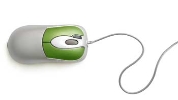
Advantages
- Easy to use
- Not very expensive
- Moves the cursor faster than the arrow keys of the keyboard.
Input Devices
Following are some of the important input devices which are used in a computer −
- Keyboard
- Mouse
- Joy Stick
- Light pen
- Track Ball
- Scanner
- Graphic Tablet
- Microphone
- Magnetic Ink Card Reader(MICR)
- Optical Character Reader(OCR)
- Bar Code Reader
- Optical Mark Reader(OMR)
Keyboard
Keyboard is the most common and very popular input device which helps to input data to the computer. The layout of the keyboard is like that of traditional typewriter, although there are some additional keys provided for performing additional functions.
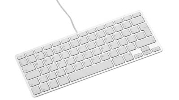
Keyboards are of two sizes 84 keys or 101/102 keys, but now keyboards with 104 keys or 108 keys are also available for Windows and Internet.
The keys on the keyboard are as follows –
S.No | Keys & Description |
1 | Typing Keys These keys include the letter keys (A-Z) and digit keys (09) which generally give the same layout as that of typewriters. |
2 | Numeric Keypad It is used to enter the numeric data or cursor movement. Generally, it consists of a set of 17 keys that are laid out in the same configuration used by most adding machines and calculators. |
3 | Function Keys The twelve function keys are present on the keyboard which are arranged in a row at the top of the keyboard. Each function key has a unique meaning and is used for some specific purpose. |
4 | Control keys These keys provide cursor and screen control. It includes four directional arrow keys. Control keys also include Home, End, Insert, Delete, Page Up, Page Down, Control(Ctrl), Alternate(Alt), Escape(Esc). |
5 | Special Purpose Keys Keyboard also contains some special purpose keys such as Enter, Shift, Caps Lock, Num Lock, Space bar, Tab, and Print Screen. |
Mouse
Mouse is the most popular pointing device. It is a very famous cursor-control device having a small palm size box with a round ball at its base, which senses the movement of the mouse and sends corresponding signals to the CPU when the mouse buttons are pressed.
Generally, it has two buttons called the left and the right button and a wheel is present between the buttons. A mouse can be used to control the position of the cursor on the screen, but it cannot be used to enter text into the computer.

Advantages
- Easy to use
- Not very expensive
- Moves the cursor faster than the arrow keys of the keyboard.
Joystick
Joystick is also a pointing device, which is used to move the cursor position on a monitor screen. It is a stick having a spherical ball at its both lower and upper ends. The lower spherical ball moves in a socket. The joystick can be moved in all four directions.
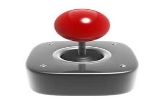
The function of the joystick is similar to that of a mouse. It is mainly used in Computer Aided Designing (CAD) and playing computer games.
Light Pen
Light pen is a pointing device similar to a pen. It is used to select a displayed menu item or draw pictures on the monitor screen. It consists of a photocell and an optical system placed in a small tube.

When the tip of a light pen is moved over the monitor screen and the pen button is pressed, its photocell sensing element detects the screen location and sends the corresponding signal to the CPU.
Track Ball
Track ball is an input device that is mostly used in notebook or laptop computer, instead of a mouse. This is a ball which is half inserted and by moving fingers on the ball, the pointer can be moved.

Since the whole device is not moved, a track ball requires less space than a mouse. A track ball comes in various shapes like a ball, a button, or a square.
Scanner
Scanner is an input device, which works more like a photocopy machine. It is used when some information is available on paper and it is to be transferred to the hard disk of the computer for further manipulation.
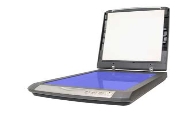
Scanner captures images from the source which are then converted into a digital form that can be stored on the disk. These images can be edited before they are printed.
Digitizer
Digitizer is an input device which converts analog information into digital form. Digitizer can convert a signal from the television or camera into a series of numbers that could be stored in a computer. They can be used by the computer to create a picture of whatever the camera had been pointed at.
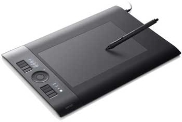
Digitizer is also known as Tablet or Graphics Tablet as it converts graphics and pictorial data into binary inputs. A graphic tablet as digitizer is used for fine works of drawing and image manipulation applications.
Microphone
Microphone is an input device to input sound that is then stored in a digital form.
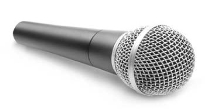
The microphone is used for various applications such as adding sound to a multimedia presentation or for mixing music.
Magnetic Ink Card Reader (MICR)
MICR input device is generally used in banks as there are large number of cheques to be processed every day. The bank's code number and cheque number are printed on the cheques with a special type of ink that contains particles of magnetic material that are machine readable.
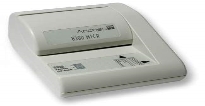
This reading process is called Magnetic Ink Character Recognition (MICR). The main advantages of MICR is that it is fast and less error prone.
Optical Character Reader (OCR)
OCR is an input device used to read a printed text.

OCR scans the text optically, character by character, converts them into a machine readable code, and stores the text on the system memory.
Bar Code Readers
Bar Code Reader is a device used for reading bar coded data (data in the form of light and dark lines). Bar coded data is generally used in labelling goods, numbering the books, etc. It may be a handheld scanner or may be embedded in a stationary scanner.

Bar Code Reader scans a bar code image, converts it into an alphanumeric value, which is then fed to the computer that the bar code reader is connected to.
Optical Mark Reader (OMR)
OMR is a special type of optical scanner used to recognize the type of mark made by pen or pencil. It is used where one out of a few alternatives is to be selected and marked.

It is specially used for checking the answer sheets of examinations having multiple choice questions.
Output Devices
Following are some of the important output devices used in a computer.
- Monitors
- Graphic Plotter
- Printer
Monitors
Monitors, commonly called as Visual Display Unit (VDU), are the main output device of a computer. It forms images from tiny dots, called pixels that are arranged in a rectangular form. The sharpness of the image depends upon the number of pixels.
There are two kinds of viewing screen used for monitors.
- Cathode-Ray Tube (CRT)
- Flat-Panel Display
Cathode-Ray Tube (CRT) Monitor
The CRT display is made up of small picture elements called pixels. The smaller the pixels, the better the image clarity or resolution. It takes more than one illuminated pixel to form a whole character, such as the letter ‘e’ in the word help.
A finite number of characters can be displayed on a screen at once. The screen can be divided into a series of character boxes - fixed location on the screen where a standard character can be placed. Most screens are capable of displaying 80 characters of data horizontally and 25 lines vertically.
There are some disadvantages of CRT −
- Large in Size
- High power consumption
Flat-Panel Display Monitor
The flat-panel display refers to a class of video devices that have reduced volume, weight and power requirement in comparison to the CRT. You can hang them on walls or wear them on your wrists. Current uses of flat-panel displays include calculators, video games, monitors, laptop computer, and graphics display.
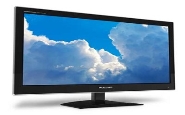
The flat-panel display is divided into two categories −
- Emissive Displays− Emissive displays are devices that convert electrical energy into light. For example, plasma panel and LED (Light-Emitting Diodes).
- Non-Emissive Displays− Non-emissive displays use optical effects to convert sunlight or light from some other source into graphics patterns. For example, LCD (Liquid-Crystal Device).
Printers
Printer is an output device, which is used to print information on paper.
There are two types of printers −
- Impact Printers
- Non-Impact Printers
Impact Printers
Impact printers print the characters by striking them on the ribbon, which is then pressed on the paper.
Characteristics of Impact Printers are the following −
- Very low consumable costs
- Very noisy
- Useful for bulk printing due to low cost
- There is physical contact with the paper to produce an image
These printers are of two types −
- Character printers
- Line printers
Character Printers
Character printers are the printers which print one character at a time.
These are further divided into two types:
- Dot Matrix Printer(DMP)
- Daisy Wheel
Dot Matrix Printer
In the market, one of the most popular printers is Dot Matrix Printer. These printers are popular because of their ease of printing and economical price. Each character printed is in the form of pattern of dots and head consists of a Matrix of Pins of size (5*7, 7*9, 9*7 or 9*9) which come out to form a character which is why it is called Dot Matrix Printer.
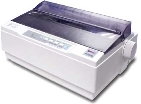
Advantages
- Inexpensive
- Widely Used
- Other language characters can be printed
Disadvantages
- Slow Speed
- Poor Quality
Daisy Wheel
Head is lying on a wheel and pins corresponding to characters are like petals of Daisy (flower) which is why it is called Daisy Wheel Printer. These printers are generally used for word-processing in offices that require a few letters to be sent here and there with very nice quality.
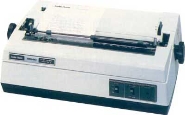
Advantages
- More reliable than DMP
- Better quality
- Fonts of character can be easily changed
Disadvantages
- Slower than DMP
- Noisy
- More expensive than DMP
Line Printers
Line printers are the printers which print one line at a time.
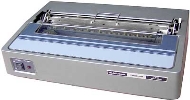
These are of two types −
- Drum Printer
- Chain Printer
Drum Printer
This printer is like a drum in shape hence it is called drum printer. The surface of the drum is divided into a number of tracks. Total tracks are equal to the size of the paper, i.e. for a paper width of 132 characters, drum will have 132 tracks. A character set is embossed on the track. Different character sets available in the market are 48 character set, 64 and 96 characters set. One rotation of drum prints one line. Drum printers are fast in speed and can print 300 to 2000 lines per minute.
Advantages
- Very high speed
Disadvantages
- Very expensive
- Characters fonts cannot be changed
Chain Printer
In this printer, a chain of character sets is used, hence it is called Chain Printer. A standard character set may have 48, 64, or 96 characters.
Advantages
- Character fonts can easily be changed.
- Different languages can be used with the same printer.
Disadvantages
- Noisy
Non-impact Printers
Non-impact printers print the characters without using the ribbon. These printers print a complete page at a time, thus they are also called as Page Printers.
These printers are of two types −
- Laser Printers
- Inkjet Printers
Characteristics of Non-impact Printers
- Faster than impact printers
- They are not noisy
- High quality
- Supports many fonts and different character size
Laser Printers
These are non-impact page printers. They use laser lights to produce the dots needed to form the characters to be printed on a page.
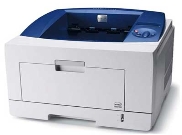
Advantages
- Very high speed
- Very high quality output
- Good graphics quality
- Supports many fonts and different character size
Disadvantages
- Expensive
- Cannot be used to produce multiple copies of a document in a single printing
Inkjet Printers
Inkjet printers are non-impact character printers based on a relatively new technology. They print characters by spraying small drops of ink onto paper. Inkjet printers produce high quality output with presentable features.

They make less noise because no hammering is done and these have many styles of printing modes available. Color printing is also possible. Some models of Inkjet printers can produce multiple copies of printing also.
Advantages
- High quality printing
- More reliable
Disadvantages
- Expensive as the cost per page is high
- Slow as compared to laser printer
A memory is just like a human brain. It is used to store data and instructions. Computer memory is the storage space in the computer, where data is to be processed and instructions required for processing are stored. The memory is divided into large number of small parts called cells. Each location or cell has a unique address, which varies from zero to memory size minus one. For example, if the computer has 64k words, then this memory unit has 64 * 1024 = 65536 memory locations. The address of these locations varies from 0 to 65535.
Memory is primarily of three types −
- Cache Memory
- Primary Memory/Main Memory
- Secondary Memory
Cache Memory
Cache memory is a very high speed semiconductor memory which can speed up the CPU. It acts as a buffer between the CPU and the main memory. It is used to hold those parts of data and program which are most frequently used by the CPU. The parts of data and programs are transferred from the disk to cache memory by the operating system, from where the CPU can access them.

Advantages
The advantages of cache memory are as follows −
- Cache memory is faster than main memory.
- It consumes less access time as compared to main memory.
- It stores the program that can be executed within a short period of time.
- It stores data for temporary use.
Disadvantages
The disadvantages of cache memory are as follows −
- Cache memory has limited capacity.
- It is very expensive.
Primary Memory (Main Memory)
Primary memory holds only those data and instructions on which the computer is currently working. It has a limited capacity and data is lost when power is switched off. It is generally made up of semiconductor device. These memories are not as fast as registers. The data and instruction required to be processed resides in the main memory. It is divided into two subcategories RAM and ROM.

Characteristics of Main Memory
- These are semiconductor memories.
- It is known as the main memory.
- Usually volatile memory.
- Data is lost in case power is switched off.
- It is the working memory of the computer.
- Faster than secondary memories.
- A computer cannot run without the primary memory.
Secondary Memory
This type of memory is also known as external memory or non-volatile. It is slower than the main memory. These are used for storing data/information permanently. CPU directly does not access these memories, instead they are accessed via input-output routines. The contents of secondary memories are first transferred to the main memory, and then the CPU can access it. For example, disk, CD-ROM, DVD, etc.

Characteristics of Secondary Memory
- These are magnetic and optical memories.
- It is known as the backup memory.
- It is a non-volatile memory.
- Data is permanently stored even if power is switched off.
- It is used for storage of data in a computer.
- Computer may run without the secondary memory.
- Slower than primary memories.
A memory is just like a human brain. It is used to store data and instruction. Computer memory is the storage space in computer where data is to be processed and instructions required for processing are stored.
The memory is divided into large number of small parts. Each part is called a cell. Each location or cell has a unique address which varies from zero to memory size minus one.
For example if computer has 64k words, then this memory unit has 64 * 1024 = 65536 memory location. The address of these locations varies from 0 to 65535.
Memory is primarily of two types
- Internal Memory− cache memory and primary/main memory
- External Memory− magnetic disk / optical disk etc.
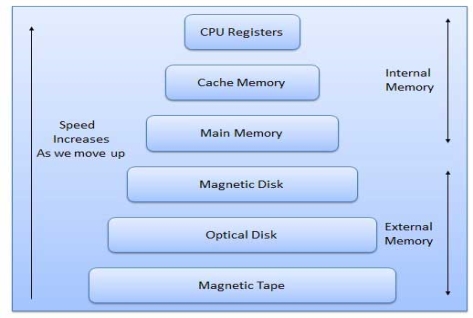
Characteristics of Memory Hierarchy are following when we go from top to bottom.
- Capacity in terms of storage increases.
- Cost per bit of storage decreases.
- Frequency of access of the memory by the CPU decreases.
- Access time by the CPU increases.
RAM
A RAM constitutes the internal memory of the CPU for storing data, program and program result. It is read/write memory. It is called random access memory (RAM).
Since access time in RAM is independent of the address to the word that is, each storage location inside the memory is as easy to reach as other location & takes the same amount of time. We can reach into the memory at random & extremely fast but can also be quite expensive.
RAM is volatile, i.e. data stored in it is lost when we switch off the computer or if there is a power failure. Hence, a backup uninterruptible power system (UPS) is often used with computers. RAM is small, both in terms of its physical size and in the amount of data it can hold.
RAM is of two types
- Static RAM (SRAM)
- Dynamic RAM (DRAM)
Static RAM (SRAM)
The word static indicates that the memory retains its contents as long as power remains applied. However, data is lost when the power gets down due to volatile nature. SRAM chips use a matrix of 6-transistors and no capacitors. Transistors do not require power to prevent leakage, so SRAM need not have to be refreshed on a regular basis.
Because of the extra space in the matrix, SRAM uses more chips than DRAM for the same amount of storage space, thus making the manufacturing costs higher.
Static RAM is used as cache memory needs to be very fast and small.
Dynamic RAM (DRAM)
DRAM, unlike SRAM, must be continually refreshed in order for it to maintain the data. This is done by placing the memory on a refresh circuit that rewrites the data several hundred times per second. DRAM is used for most system memory because it is cheap and small. All DRAMs are made up of memory cells. These cells are composed of one capacitor and one transistor.
ROM
ROM stands for Read Only Memory. The memory from which we can only read but cannot write on it. This type of memory is non-volatile. The information is stored permanently in such memories during manufacture.
A ROM, stores such instruction as are required to start computer when electricity is first turned on, this operation is referred to as bootstrap. ROM chip are not only used in the computer but also in other electronic items like washing machine and microwave oven.
Following are the various types of ROM −
MROM (Masked ROM)
The very first ROMs were hard-wired devices that contained a pre-programmed set of data or instructions. These kind of ROMs are known as masked ROMs. It is inexpensive ROM.
PROM (Programmable Read Only Memory)
PROM is read-only memory that can be modified only once by a user. The user buys a blank PROM and enters the desired contents using a PROM programmer. Inside the PROM chip there are small fuses which are burnt open during programming. It can be programmed only once and is not erasable.
EPROM (Erasable and Programmable Read Only Memory)
The EPROM can be erased by exposing it to ultra-violet light for a duration of upto 40 minutes. Usually, an EPROM eraser achieves this function. During programming an electrical charge is trapped in an insulated gate region. The charge is retained for more than ten years because the charge has no leakage path. For erasing this charge, ultra-violet light is passed through a quartz crystal window (lid). This exposure to ultra-violet light dissipates the charge. During normal use the quartz lid is sealed with a sticker.
EEPROM (Electrically Erasable and Programmable Read Only Memory)
The EEPROM is programmed and erased electrically. It can be erased and reprogrammed about ten thousand times. Both erasing and programming take about 4 to 10 ms (millisecond). In EEPROM, any location can be selectively erased and programmed. EEPROMs can be erased one byte at a time, rather than erasing the entire chip. Hence, the process of re-programming is flexible but slow.
Serial Access Memory
Sequential access means the system must search the storage device from the beginning of the memory address until it finds the required piece of data. Memory device which supports such access is called a Sequential Access Memory or Serial Access Memory. Magnetic tape is an example of serial access memory.
Direct Access Memory
Direct access memory or Random Access Memory, refers to conditions in which a system can go directly to the information that the user wants. Memory device which supports such access is called a Direct Access Memory. Magnetic disks, optical disks are examples of direct access memory.
Cache Memory
Cache memory is a very high speed semiconductor memory which can speed up CPU. It acts as a buffer between the CPU and main memory. It is used to hold those parts of data and program which are most frequently used by CPU. The parts of data and programs, are transferred from disk to cache memory by operating system, from where CPU can access them.
Advantages
- Cache memory is faster than main memory.
- It consumes less access time as compared to main memory.
- It stores the program that can be executed within a short period of time.
- It stores data for temporary use.
Disadvantages
- Cache memory has limited capacity.
- It is very expensive.
Virtual memory
Virtual memory is a technique that allows the execution of processes which are not completely available in memory. The main visible advantage of this scheme is that programs can be larger than physical memory. Virtual memory is the separation of user logical memory from physical memory.
This separation allows an extremely large virtual memory to be provided for programmers when only a smaller physical memory is available. Following are the situations, when entire program is not required to be loaded fully in main memory.
- User written error handling routines are used only when an error occurred in the data or computation.
- Certain options and features of a program may be used rarely.
- Many tables are assigned a fixed amount of address space even though only a small amount of the table is actually used.
- The ability to execute a program that is only partially in memory would counter many benefits.
- Less number of I/O would be needed to load or swap each user program into memory.
- A program would no longer be constrained by the amount of physical memory that is available.
- Each user program could take less physical memory, more programs could be run the same time, with a corresponding increase in CPU utilization and throughput.
Auxiliary Memory
Auxiliary memory is much larger in size than main memory but is slower. It normally stores system programs, instruction and data files. It is also known as secondary memory. It can also be used as an overflow/virtual memory in case the main memory capacity has been exceeded. Secondary memories cannot be accessed directly by a processor. First the data/information of auxiliary memory is transferred to the main memory and then that information can be accessed by the CPU.
Characteristics of Auxiliary Memory are following −
- Non-volatile memory− Data is not lost when power is cut off.
- Reusable−The data stays in the secondary storage on permanent basis until it is not overwritten or deleted by the user.
- Reliable− Data in secondary storage is safe because of high physical stability of secondary storage device.
- Convenience−With the help of a computer software, authorised people can locate and access the data quickly.
- Capacity− Secondary storage can store large volumes of data in sets of multiple disks.
- Cost− It is much lesser expensive to store data on a tape or disk than primary memory.
You know that processor memory, also known as primary memory, is expensive as well as limited. The faster primary memories are also volatile. If we need to store large amount of data or programs permanently, we need a cheaper and permanent memory. Such memory is called secondary memory. Here we will discuss secondary memory devices that can be used to store large amount of data, audio, video and multimedia files.
Characteristics of Secondary Memory
These are some characteristics of secondary memory, which distinguish it from primary memory −
- It is non-volatile, i.e. it retains data when power is switched off
- It is large capacities to the tune of terabytes
- It is cheaper as compared to primary memory
Depending on whether secondary memory device is part of CPU or not, there are two types of secondary memory – fixed and removable.
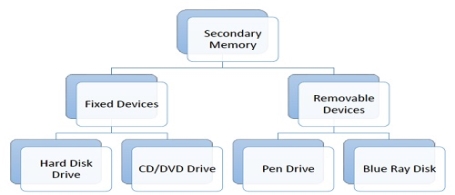
Let us look at some of the secondary memory devices available.
Hard Disk Drive
Hard disk drive is made up of a series of circular disks called platters arranged one over the other almost ½ inches apart around a spindle. Disks are made of non-magnetic material like aluminium alloy and coated with 10-20 nm of magnetic material.

Standard diameter of these disks is 14 inches and they rotate with speeds varying from 4200 rpm (rotations per minute) for personal computers to 15000 rpm for servers. Data is stored by magnetizing or demagnetizing the magnetic coating. A magnetic reader arm is used to read data from and write data to the disks. A typical modern HDD has capacity in terabytes (TB).
CD Drive
CD stands for Compact Disk. CDs are circular disks that use optical rays, usually lasers, to read and write data. They are very cheap as you can get 700 MB of storage space for less than a dollar. CDs are inserted in CD drives built into CPU cabinet. They are portable as you can eject the drive, remove the CD and carry it with you. There are three types of CDs −
- CD-ROM (Compact Disk – Read Only Memory)−The data on these CDs are recorded by the manufacturer. Proprietary Software, audio or video are released on CD-ROMs.
- CD-R (Compact Disk – Recordable)− Data can be written by the user once on the CD-R. It cannot be deleted or modified later.
- CD-RW (Compact Disk – Rewritable)− Data can be written and deleted on these optical disks again and again.
DVD Drive
DVD stands for Digital Video Display. DVD are optical devices that can store 15 times the data held by CDs. They are usually used to store rich multimedia files that need high storage capacity. DVDs also come in three varieties – read only, recordable and rewritable.

Pen Drive
Pen drive is a portable memory device that uses solid state memory rather than magnetic fields or lasers to record data. It uses a technology similar to RAM, except that it is nonvolatile. It is also called USB drive, key drive or flash memory.

Blue Ray Disk
Blue Ray Disk (BD) is an optical storage media used to store high definition (HD) video and other multimedia filed. BD uses shorter wavelength laser as compared to CD/DVD. This enables writing arm to focus more tightly on the disk and hence pack in more data. BDs can store up to 128 GB data.
Magnetic Disk in Computer Architecture-
In computer architecture,
- Magnetic disk is a storage device that is used to write, rewrite and access data.
- It uses a magnetization process.
Architecture-
- The entire disk is divided into platters.
- Each platter consists of concentric circles called as tracks.
- These tracks are further divided into sectors which are the smallest divisions in the disk.

- A cylinder is formed by combining the tracks at a given radius of a disk pack.
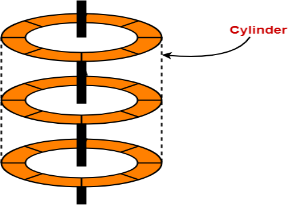
- There exists a mechanical arm called as Read / Write head.
- It is used to read from and write to the disk.
- Head has to reach at a particular track and then wait for the rotation of the platter.
- The rotation causes the required sector of the track to come under the head.
- Each platter has 2 surfaces- top and bottom and both the surfaces are used to store the data.
- Each surface has its own read / write head.
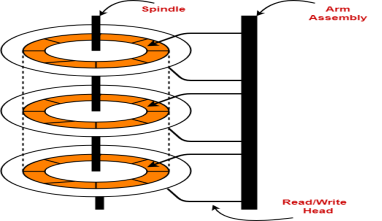
Disk Performance Parameters-
The time taken by the disk to complete an I/O request is called as disk service time or disk access time.
Components that contribute to the service time are-
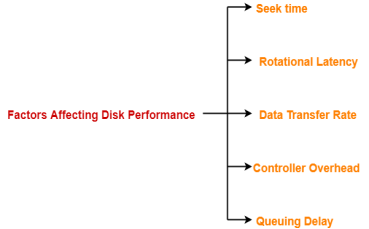
- Seek time
- Rotational latency
- Data transfer rate
- Controller overhead
- Queuing delay
1. Seek Time-
- The time taken by the read / write head to reach the desired track is called as seek time.
- It is the component which contributes the largest percentage of the disk service time.
- The lower the seek time, the faster the I/O operation.
Specifications Seek time specifications include-
1. Full Stroke-
2. Average-
3. Track to Track-
|
2. Rotational Latency-
- The time taken by the desired sector to come under the read / write head is called as rotational latency.
- It depends on the rotation speed of the spindle.
Average rotational latency = 1 / 2 x Time taken for full rotation |
3. Data Transfer Rate-
- The amount of data that passes under the read / write head in a given amount of time is called as data transfer rate.
- The time taken to transfer the data is called as transfer time.
It depends on the following factors-
- Number of bytes to be transferred
- Rotation speed of the disk
- Density of the track
- Speed of the electronics that connects the disk to the computer
4. Controller Overhead-
- The overhead imposed by the disk controller is called as controller overhead.
- Disk controller is a device that manages the disk.
5. Queuing Delay-
- The time spent waiting for the disk to become free is called as queuing delay.
NOTE-
All the tracks of a disk have the same storage capacity. |
Storage Density-
- All the tracks of a disk have the same storage capacity.
- This is because each track has different storage density.
- Storage density decreases as we from one track to another track away from the center.
Thus,
- Innermost track has maximum storage density.
- Outermost track has minimum storage density.
Important Formulas-
1. Disk Access Time-
Disk access time is calculated as-
Disk access time = Seek time + Rotational delay + Transfer time + Controller overhead + Queuing delay |
2. Average Disk Access Time-
Average disk access time is calculated as-
Average disk access time = Average seek time + Average rotational delay + Transfer time + Controller overhead + Queuing delay |
3. Average Seek Time-
Average seek time is calculated as-
Average seek time = 1 / 3 x Time taken for one full stroke |
Alternatively,
If time taken by the head to move from one track to adjacent track = t units and there are total k tracks, then-
Average seek time
= { Time taken to move from track 1 to track 1 + Time taken to move from track 1 to last track } / 2
= { 0 + (k-1)t } / 2
= (k-1)t / 2
4. Average Rotational Latency-
Average rotational latency is calculated as-
Average rotational latency = 1 / 2 x Time taken for one full rotation |
Average rotational latency may also be referred as-
- Average rotational delay
- Average latency
- Average delay
5. Capacity Of Disk Pack-
Capacity of a disk pack is calculated as-
Capacity of a disk pack = Total number of surfaces x Number of tracks per surface x Number of sectors per track x Storage capacity of one sector |
6. Formatting Overhead-
Formatting overhead is calculated as-
Formatting overhead = Number of sectors x Overhead per sector |
7. Formatted Disk Space-
Formatted disk space also called as usable disk space is the disk space excluding formatting overhead.
It is calculated as-
Formatted disk space = Total disk space or capacity – Formatting overhead |
8. Recording Density Or Storage Density-
Recording density or Storage density is calculated as-
Storage density of a track = Capacity of the track / Circumference of the track |
From here, we can infer-
Storage density of a track ∝ 1 / Circumference of the track
9. Track Capacity-
Capacity of a track is calculated as-
Capacity of a track = Recording density of the track x Circumference of the track |
10. Data Transfer Rate-
Data transfer rate is calculated as-
Data transfer rate = Number of heads x Bytes that can be read in one full rotation x Number of rotations in one second |
OR
Data transfer rate = Number of heads x Capacity of one track x Number of rotations in one second |
11. Tracks Per Surface-
Total number of tracks per surface is calculated as-
Total number of tracks per surface = (Outer radius – Inner radius) / Inter track gap |
Points to Remember-
- The entire disk space is not usable for storage because some space is wasted in formatting.
- When rotational latency is not given, use average rotational latency for solving numerical problems.
- When seek time is not given, use average seek time for solving numerical problems.
- It is wrong to say that as we move from one track to another away from the center, the capacity increases.
- All the tracks have same storage capacity.
Optical disk
An optical disk is primarily used as a portable and secondary storage device. It can store more data than the previous generation of magnetic storage media, and has a relatively longer lifespan. Compact disks (CD), digital versatile/video disks (DVD) and Blu-ray disks are currently the most commonly used forms of optical disks. These disks are generally used to:
- Distribute software to customers
- Store large amounts of data such as music, images and videos
- Transfer data to different computers or devices
- Back up data from a local machine
What is Numerical Data
Numerical data is a data type expressed in numbers, rather than natural language description. Sometimes called quantitative data,numerical data is always collected in number form. Numerical data differentiates itself with other number form data types with its ability to carry out arithmetic operations with these numbers.
For example, numerical data of the number of male students and female students in a class may be taken, then added together to get the total number of students in the class. This characteristic is one of the major ways of identifying numerical data.
What are the Types of Numerical Data?
There are two types of numerical data, namely; discrete data-which represent countable items and continuous data-which represent data measurement. The continuous types of numerical data are further sub-divided into interval and ratio data, which is known to be used for measuring items.
- Discrete Data
Discrete Data is a type of numerical data which represents countable items. They take on values that can be grouped into a list, where the list may either be finite or infinite. Whether finite or infinite, discrete data take on counting numbers like 1 to 10 or 1 to infinity, with these group of numbers being countably finite and countably infinite respectively.
A more practical example of discrete data will be counting the cups of water required to empty a bucket and counting the cups of water required to empty an ocean—the former is finite countable while the latter is infinite countable.
- Continuous Data:
This is atype of numerical data which represents measurements—their values are described as intervals on a real number line, rather than take counting numbers. For example, the Cumulative Grade Point Average (CGPA) in a 5 point grading system defines first-class students as those whose CGPA falls under 4.50 - 5.00, second class upper as 3.50 - 4.49, second class lower as 2.50 - 3.49, third class as 1.5 - 2.49, pass as 1.00 - 1.49 and fail as 0.00 - 0.99..
A student may score a point 4.495, 2.125, 3.5 or any possible number from 0 to 5. In this case, the continuous data is regarded as being uncountable finite.
Continuous data may be subdivided into two types, namely; Interval & Ratio Data.
- Interval Data
This is a data type measured along a scale, in which each point is placed at an equal distance from one another. Interval data takes numerical values that can only take the addition and subtraction operations.
For example, the temperature of a body measured in degrees Celsius or degrees Fahrenheit is regarded as interval data. This temperature does not have a zero point.
- Ratio Data
Ratio data is a continuous data type similar to interval data, but has a zero point. In other words, ratio data is an interval data with zero point. For ratio data, the temperature may not only be measured in degrees Celsius and degrees Fahrenheit, but also in Kelvin. The presence of zero-point accommodates the measurement of 0 Kelvin.
General Characteristics/Features of Numerical Data
- Categories: There are two main categories of numerical data, namely; discrete and continuous data. Continuous data is then further broken down into interval and ratio data.
- Quantitativeness: Numerical data is sometimes called quantitative data due to its quantitative nature. Unlike categorical data which takes quantitative values with qualitative characteristics, numerical data exhibits quantitative features. .
- Arithmetic Operation: One can perform arithmetic operations like addition and subtraction on numerical data. True to its quantitative character, almost all statistical analysis is applicable when analyzing numerical data.
- Estimation & Enumeration: Numerical data can both be estimated an enumerated. In a case whereby the numerical data is precise, it may be enumerated. However, if it is not precise, the data is estimated. When computing the CGPA of a student, for instance, a 4.495623 CGPA is rounded up to 4.50.
- Interval difference: The difference between each interval on a numerical data scale is equal. For example, the difference between 5 minutes and 10 minutes on a wall clock is the same as the difference between 10 and 15 minutes.
- Analysis: Numerical data is analyzed using descriptive and inferential statistical methods, depending on the aim of the research. Some of the descriptive-analytical methods include; mean, median, variance, etc. Inferential statistical methods like TURF analysis, trend analysis, SWOT analysis etc. are also used for numerical data analysis.
- Data Visualisation: Numerical data may be visualised in different ways depending on the type of data being investigated. Some of the data visualisation techniques adopted by numerical data include; scatter plot, dot plot, stacked dot plot, histograms, etc.
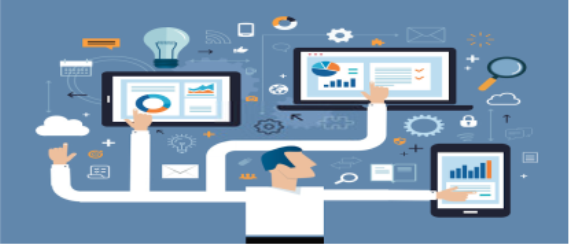
What are the Examples of Numerical Data?
Numerical data examples which are usually expressed in numbers includes; census data, temperature, age, mark grading, annual income, time, height, IQ, CGPA etc. These numerical examples, either in countable numbers as in discrete data or measurement form like continuous data call all be labelled as an example of numerical data
- Census: The Federal Government periodically needs to conduct the census of a country to know the country's population and demographics of this population. A head-to-head count of the country’s resident is done using numerical data.
Knowing the Census of a country assists the Government in making proper economic decisions. It is an example of countably finite discrete data.
- Temperature: The temperature of a given body or place is measured using numerical data. The body temperature of a body, given to be 37 degrees Celsius is an example of continuous data.
This data type also put into consideration the unit of measurement. Interval data, for instance, can only measure in degrees Celsius and Fahrenheit, while ratio data can also measure in Kelvin.
- Age: The age of an individual is counted using numerical data. It is classified as quantitative because it can take up multiple numerical values.
Although numbers are infinite in the real sense, the number of years people spend in life is finite, making it a countably finite discrete data. For example, a person who is 20 years old today may finish high school at 16, 4 years ago.
- Mark Grading: Numerical data is used when grading test scores. Most times, these marks are uncountably finite and fall under continuous data.
When applying for admission in a school, for instance, your O level results may add up to your score. Therefore, the admission board may ask you to input your grades—A is 5 points, B is 4 points, C is 3 points, D is 2 points and E is 1 point. All these points are added together to make your total admission score.
- Annual income: The annual income of an individual or household is an example of numerical data, used by businesses to know the purchasing power of their customers or each household in a community. This knowledge influences the price of their products. The annual income of an individual or household is a countably finite discrete data.
- Time: The amount of time it took a runner to run a race, for instance, is numerical data. It doesn't matter whether it is being measured in hours, seconds or minutes, it always takes a numeric value. Time is an example of continuous data. It is regarded as interval data if measured on a 12-hour clock.
- Height: A person's height could be any value (within the range of human heights), not just certain fixed heights. This height takes a numeric value which varies in person and can increase as time goes on.
The height of a person, measured in centimetres, metres, inches etc. is continuous data.
- IQ Test Score: Most IQ tests rate a person's IQ in terms of percentage. The percentage of IQ is derived from the participant’s score in various sub-tests.
This score is not only quantitative but also has quantitative properties. An IQ test score is an example of uncountably finite categorical data.
- Weight: Weight is a variable element in humans. A person might weigh 50kg while another might weigh 80kg. Unlike height that may not decrease, weight may increase and decrease in a person.
The weight of a person measured in kg is a numerical data and may be an indication of fat or slim which is a categorical variable.
- CGPA: This represents a student's Grade Point Average in his/her studies over a set period e.g. One semester. The mean of the GPA is used to find the CGPA of a student over a longer period e.g. Two sessions. CGPA is an example of interval data.
- The number of children: The number of children in a community, for instance, is a superset of the number of children in a home. In other words, the number of children in each home is what adds up to make the total number of children in counting.
This exhibits the characteristics of numerical data and is a countably finite discrete data example.
- Number of students: Similarly, the number of students in a class is a superset of the number of males and females in a class. That is, the number of males and females is what adds up to make the total number of students in a class.
The number of students in a class is also a countably finite discrete data example.
- Results of rolling a dice: A die has six faces, with each face representing one of the numbers from 1 to 6. When you roll a dice, you get two numbers which may add up to one of 2, 3, 4, 5, 6, 7, 8, 9, 10, 11 and 12.
Therefore, the results of rolling dice is a countably finite discrete data example.
- Length: Let us consider the length of a leaf for example, which is similar to the height in human beings. A leaf’s length could be any value, not just certain fixed length.
This height takes a numeric value which varies in plants and can increase as the plant grows. The length of a leaf measured in centimetres is continuous data.
Numerical Data Variables
A numerical variable is a data variable that takes on any value within a finite or infinite interval (e.g. Length, test scores, etc.). Numerical variable can also be called a continuous variable because it exhibits the features of continuous data. Unlike discrete data, continuous data takes on both finite and infinite values.
There are two types of numerical variables, namely; interval and ratio variables.
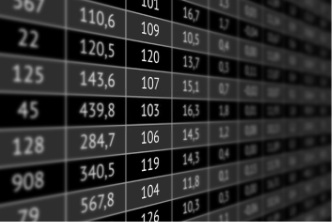
An interval variable has values with interpretable differenced, but no true zero. A good example is a temperature when measured in degrees Celsius and degrees Fahrenheit.
Interval variable can be added and subtracted, but cannot be multiplied and divided. Ratio variable, on the other hand, does all this.
Interval Variable
Interval variable is an extension of the ordinal variable, with a standardised difference betweenvariables in the interval. There are two distributions on interval variables, namely; normal distribution and non-normal distribution
Normal Distribution
A real-valued random variable is said to be normally distributed if its distribution is unknown. We consider two main samples of normal distribution and carry out different tests on them.
Matched Sample
Tests
- Paired t-test: This is used to compare two sample population means.
- Repeated measures
- ANOVA: This compares means across three or more variables, based on repeated observations.
Unmatched Sample
Tests
- Unpaired t-test: This is used to compare two sample population means.
- ANOVA: This compares means across three or more variables, based on a single observation.
Non-Normal Distribution
A real-valued random variable is said to be non-normally distributed if its distribution is known. We consider two main samples of non-normal distribution and carry out different tests on them
Matched Sample
Tests
- Wilcoxon rank-sum test: This is used to compare two groups of matched samples.
- Friedman 2-way ANOVA: This is used to compare the difference in means across 3 or more groups.
Unmatched Sample
Tests
- Wilcoxon rank-sum test: This test is used when the requirements for the t-test of two unmatched samples are not satisfied.
- Kruskal-Wallis test: This is used to investigate whether three or more groups of unmatched samples originate from the same distribution.
Ratio Variable
Ratio variable is an extension of interval variable, with values with a true zero and can be added, subtracted, multiplied or divided. The tests carried out on these variables are similar to those of interval variables.
Numerical Data Analysis
Numerical data analysis can be interpreted using two main statistical methods of analysis, namely; descriptive statistics and inferential statistics. Numerical analysis in inferential statistics can be interpreted with swot, trend and conjoint analysis while descriptive statistics makes use of measures of central tendency,
Descriptive Statistics
Descriptive statistics is used to describe a sample population using data sets collected from that population. Descriptive statistical methods used in analysing numerical data are; mean, median, mode, variance, standard deviation, etc.
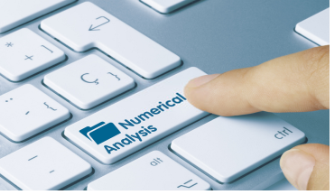
Inferential Statistics
Inferential is used to make predictions or inference on a large population-based on the data collected from a sample population. Below are some of the methods used for analysing numerical data.
- Trend analysis: Trend analysis is an interval data analysis technique, used to draw trends and insights by capturing survey data over a certain period.
- SWOT analysis: SWOT is an acronym for Strengths, Weaknesses, Opportunities and Threats. Strengths and Weaknesses are for internal analysis, while Opportunities and Threats are for external analysis of an organisation.
- Conjoint analysis: This is a market research analysis technique that investigates how people make choices.
- TURF analysis: This is an acronym for Total Unduplicated Reach and Frequency analysis, and is used to assess the market potential for a combination of products or services.
Uses of Numerical Data
- Population Prediction
Using Trend analysis, researchers gather the data of the birth rate in a country for a certain period and use it to predict future population. Predicting a country's population has a lot of economic importance.
- Marketing & Advertising
Before engaging in any marketing or advertising campaign, companies need to first analyse some internal and external factors that may affect the campaign. In most cases, they use a SWOT analysis.
- Research
Numerical data is very popular among researchers due to its compatibility with most statistical techniques. It helps ease the research process.
- Product Development
During the product development stage, product researchers use TURF analysis to investigate whether a new product or service will be well-received in the target market or not.
- Education
Interval data is used in the education sector to compute the grading system. When calculating the Cumulative Grade Point Average of a student, the examiner uses an interval data of the student's scores in the various courses offered.
- Medicine
Doctors use the thermometer to measure a patient's body temperature as part of a medical check-up. In most cases, body temperature is measured in Celsius, therefore passing as interval data.
Disadvantages of Numerical Data
- Preset answers that do not reflect how people feel about a subject.
- “Standard” questions from researchers may lead to structural bias.
- Results are limited.
What is the best tool to collect Numerical Data?
Numerical data is one of the most useful data types in statistical analysis. Formplus provides its users with a repository of great features to go with it. With Formplus web-based data collection tool, you have access to features that will assist you in making strategic business decisions. This way, you can improve business sales, launch better products and serve customers better.
Conclusion
Numerical data research techniques employ inquiry strategies such as experiments and surveys. The findings may be predictive, explanatory, and confirming.
It involves the collection of data which is then subjected to statistical treatment to support or refute a hypothesis. Thus, numerical data collection techniques are used to gather data from different reliable sources, which deal with numbers, statistics, charts, graphs, tables, etc.
Earlier computers were used only for the purpose of calculations i.e. they were only used as a calculating device. But now computers are not just used for numeric representations, they are also used to represent information such as names, addresses, item descriptions etc. Such information is represented using letters and symbols. Computer is a digital system and can only deal with l’s and 0’s. So to deal with letters and symbols they use alphanumeric codes.
Alphanumeric codes, also called character codes, are binary codes used to represent alphanumeric data. The codes write alphanumeric data, including letters of the alphabet, numbers, mathematical symbols and punctuation marks, in a form that is understandable and process able by a computer. Using these codes, we can interface input-output devices such as keyboards, monitors, printers etc. with computer.
Several coding techniques have been invented that represent alphanumeric information as a series of l’s and O’s. The earliest better-known alphanumeric codes were the Morse code used in telegraph and 12-bit Hollerith code used when punch cards were used as a medium of inputting and outputting data. As the punched cards have completely vanished with the evolution of new mediums, the Hollerith code was rendered obsolete. Now the ASCII and EBCDIC codes are the two most widely used alphanumeric codes. The ASCII Code is very popular code used in all personal computers and workstations whereas the EBCDIC code is mainly alphanumeric code, the UNICODE, has evolved to overcome the limitation of limited character encoding as in case of ASCII and EBCDIC code.
Types of alphanumeric code.
MORSE CODE
The Morse code, invented in 1837 by Samuel F.B. Morse, was the first alphanumeric code used in telecommunication. It uses a standardized sequence of short and long elements to represent letters, numerals and special characters of a given message. The short and long elements can be formed by sounds, marks, pulses, on off keying and are commonly known as dots and dashes. For example: The letter ‘A’ is formed by a dot followed by a dash. The digit 5 is formed by 5 dots in succession. The International Morse code treats a dash equal to three dots. To see the details of Morse code table you can refer the Internet search engines.
Due to variable length of Morse code characters, the morse code could not adapt to automated circuits. In most electronic communication, the Baudot code and ASCII code are used.
Morse code has limited applications. It is used in communication using telegraph lines, radio circuits. Pilots and air traffic controllers also use them to transmit their identity and other information.
BAUDOT CODE
The Baudot code was another popular alphanumeric code used in early 1860’s. It was invented by the French engineer Emile Baudotin 1870. It is a 5-unit code (i.e. it uses five elements to represent an alphabet). Moreover, unlike the Morse code, all the symbols all of equal duration. This allowed telegraph transmission of the Roman alphabet and punctuation and control signals.
HOLLERITH CODE
In 1896, Herman Hollerith formed a company called the Tabulating Machine Company. This company developed a line of machines that used punched cards for tabulation. After a number of mergers, this company was formed into the IBM, Inc. We often refer to the punched-cards used in computer systems as Hollerith cards and the 12-bit code used on a punched-card is called the Hollerith code.
A Hollerith string is a sequence of l2-bit characters; they are encoded as two ASCII characters, containing 6 bits each. The first character contains punches 12, 0, 2,4,6,8 and the second character contains punches 11, 1,3,5, 7, 9. Interleaving the two characters gives the original 12 bits. To make the characters printable on ASCII terminals, bit 7 is always set to 0 and bit 6 is said to the complement of bit 5. These two bits are ignored when reading Hollerith cards.
Today, as punched cards are mostly obsolete and replaced with other storage Medias so the Hollerith code is rendered obsolete.
American Standard-Code for Information Interchange (ASCII)
The American Standard-Code for Information Interchange (ASCII) pronounced “as-kee” is a 7-bit code based on the ordering of the English alphabets. The ASCII codes are used to represent alphanumeric data in computer input/output.
Historically, ASCII developed from telegraphic codes. It was first published as a standard in 1967. It was subsequently updated and many versions of it were launched with the most recent update in 1986. Since it is a seven-bit code, it can almost represent 128 characters. These include 95 printable characters including 26 upper-case letters (A to Z), 26 lowercase letters (a to z), 10 numerals (0 to 9) and 33 special characters such as mathematical symbols, space character etc. It also defines codes for 33 non-printing obsolete characters except for carriage return and/or line feed. The below table lists the 7 bit ASCII code containing the 95 printable characters.
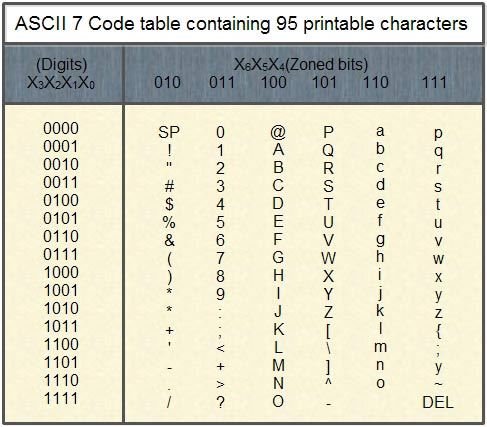
The format of ASCII code for each character is X6‘ ·Xs, X4, X3, X2, Xl‘ X0 where each X is 0’ or 1. For instance, letter D is coded as .1000100. For making reading easier, we leave space as follows: 1000100.
Similarly, from the above table, we see that letter ‘A’ has X6 X5X4 of 100 and X3 X2 Xl Xo of 0001 (A). Similarly, the digit ‘9’ has X6 X5 X4 values of 011 and X3 X2XlX0 of 1001 so the ASCII-7 code for digit 9 is 0111001.
More examples are:
The ASCll-7 code for‘d’ is 1100100 as seen from the table 3.4.
The ASCll-7 code for ‘+’ is 0101011 as seen from the table 3.4.
An eight-bit version of the ASCII code, known as US ASCII-8 or ASCII-8, has also been developed. Since it uses 8-bits, so this version of ASCII can represent a maximum of 256 characters.
The table below lists some ASCII-8 codes.
When the ASCII -7 codes was introduced, many computers dealt with eight -bit groups (or bytes) as the smallest unit of information. This eight bit code was commonly used as parity bit for detection of error on communication lines. Machines that did not use the parity bit typically set the eighth bit to O. In that case, the ASCII code format would be X7 X6 X5 X4 X3 X2 Xl X0‘ In case of ASCII-7 code, if this representation is chosen to represent characters then X7 would always be zero. So, the eight-bit ASCII-7 code for ‘A’ would be 01000001 and for 4’ would be 00101011.
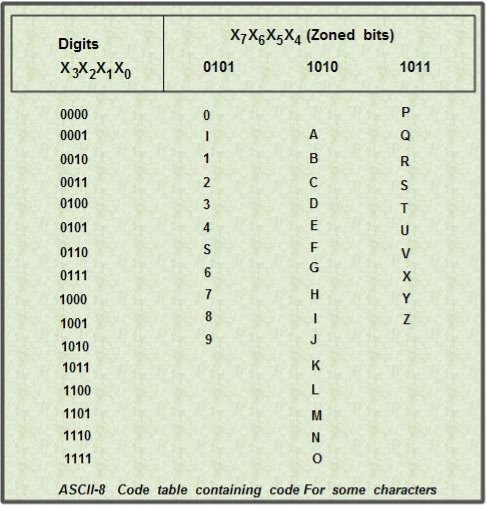
Example 1: With an ASCII-7 keyboard, each keystroke produces the ASCII equivalent of the designated character. Suppose that you type PRINT X. What is the output of an ASCII-7 keyboard?
Solution: The sequence is as follows:
The ASCII-7 equivalent of P = 101 0000
The ASCII-7 equivalent of R = 101 0010
The ASCII-7 equivalent of I = 1001010
The ASCII-7 equivalent of N = 100 1110
The ASCII-7 equivalent of T = 1-010100
The ASCII-7 equivalent of space = 010 0000
The ASCII-7 equivalent of X = 101 1000
So the output produced is 1010000101001010010101001110101010001000001011000. The output in hexadecimal equivalent is 50 52 49 4E 54 30 58
Example2: A computer sends a message to another computer using an odd-parity bit. Here is the message in ASCII-8 Code.
1011 0001
1011 0101
1010 0101
1010 0101
1010 1110
What do these numbers mean?
Solution:
On translating, the 8-bit numbers into their equivalent ASCII-8 code we get the word 1011 0001 (Q), 10110101 (U), 10100101 (E), 1010 0101 (E), 1010 1110 (N)
So, on translation we get QUEEN as the output.
Extended Binary Coded Decimal Interchange Code (EBCDIC)
The Extended Binary Coded Decimal Interchange Code (EBCDIC) pronounced as “ebi-si disk” is another frequently used code by computers for transferring alphanumeric data. It is 8-bit code in which the numerals (0-9) are represented by the 8421 BCD code preceded by 1111. Since it is a 8-bit code, it can almost represent 23 (= 256) different characters which include both lowercase and uppercase letters in addition to various other symbols and commands.
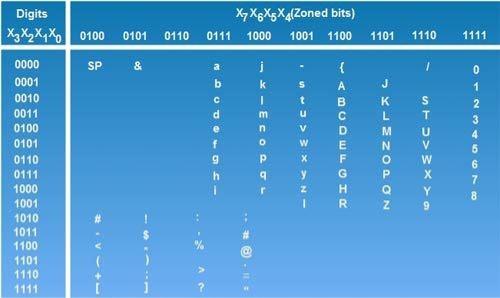
EBCDIC was designed by IBM corp. So it is basically used by several IBM· models. In this code, we do not use a straight binary sequence for representing characters, as was in the case of ASCII code. Since it is a 8-bit code, so it can be easily grouped into groups of 4 so as to represent in arm of hexadecimal digits. By using the hexadecimal number system notation, the amount of digits used to represent various characters and special characters using EBCDIC code is reduced in volume of one is to four. Thus 8-bit binary code could be reduced to 2 hexadecimal digits which are easier to decode if we want to view the internal representation in memory. The above table lists the EBCDIC code for certain characters.
Read the above table as you read the graph. Suppose you want to search for EBCDIC code for letter ‘A’. To that case, the value of X3 X2Xl X0 bits is 0001 and value X7 X6 X5 X4 bits is 1100.
Therefore, EBCDIC code for letter ‘A’ is 11000001(A). Similarly, the EBCDIC code for ‘B’ is 11000010(B).
The EBCDIC code ‘=’ is 01111110
The EBCDIC code for ‘$’ is 0101 1011
UNICODE
The ASCII and EBCDIC encodings and their variants that we have studied suffer from some limitations.
1. These encodings do not have a sufficient number of characters to be able to encode alphanumeric data of all forms, scripts and languages. As a result, they do not permit multilingual computer processing.
2. These encoding suffer from incompatibility. For example: code 7A (in hex) represents the lowercase letter ‘Z’ in ASCII code and the semicolon sign ‘;’ in EBCDIC code.
To overcome these limitations, UNICODE also known as universal code was developed jointly by the Unicode Consortium and the International Organization for Standardization (ISO). The Unicode is a 16-bit code so it can represent 65536 different characters. It is the most complete character encoding scheme that allows text of all forms and languages to be encoded for use by computers. In addition to multilingual support, it also supports a comprehensive set of mathematical and technical symbols, greatly simplifying any scientific information interchange.
UNICODE has a number of uses
1. It is increasingly being used for internal processing and storage of text. Window NT and its descendents, Java environment, Mac OS all follow Unicode as the sole internal character encoding.
2. All World Wide Web consortium recommendations have used Unicode as their document character set since HTML 4.0.
3. It partially addresses the new line problem that occurs when trying to read a text file on different platforms. It defines a large number of characters that can be recognized as line terminators.
Unicode is currently being adopted by top computer industry leaders like Microsoft, Apple, Oracle, Sun, SAP and many more in their products.
Information and Communication Technologies (ICT) refers to technologies that capture, transmit and display data and information electronically and includes all devices, applications and networking elements that allow people to connect in a digital world.
An ICT system refers to the overall set-up, consisting of hardware, software, data and its users. ICT systems as a whole include:
- People – to supply the data and to make decisions from the output supplied from the system information, which is based on the results from processing data and the output from an ICT system.
- Hardware e.g. Input devices, storage, processor, output devices and communication devices.
- Procedures – to determine what needs to be done and when. This causes the passing of data or information between people.
- Software – the computer programs which provide the step-by-step instructions to complete the task.
- Data – raw material that is processed by the system to provide the information for the output provided by the system. Data can come in different formats, such as sounds, images, and videos, etc.
In order for an ICT system to function, it needs to receive, store, retrieve, manipulate and transmit data.
Computers are programmable electronic devices designed to accept data, perform prescribed mathematical and logical operations at high speed, and display the results of these operations. Computers are used in Information Technology (IT) – which is a subset of ICT. Computers store, transmit, retrieve and manipulate data for businesses and other enterprises. Computers refer to the hardware, and since computers cannot initiate functionality on their own, they start functioning as soon as they receive data to work with (to process). This data is then stored on the computer, the computer manipulates the data according to the instructions it has received, before sending the new information back to the user.
Thus, we can say that Information technology (IT) is the development, maintenance and use of computer systems, software, and networks for processing and communicating data.
THE GENERAL MODEL OF A COMPUTER
The following illustration demonstrates a general model of a computer and shows that the functions of a computer are similar to the steps of the information processing cycle. All basic computers consist of four functions: input, storage, processing and output.
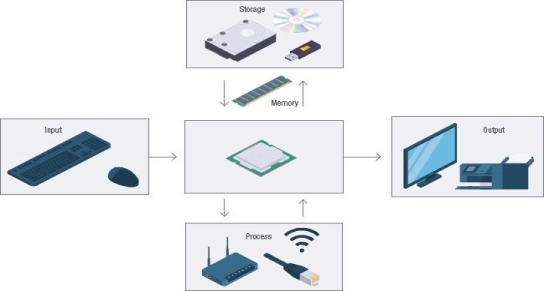
Figure 1.1:The general model of a computer
IPO is often called IPOS or input, process, output, storage. The computer receives input, processes the input as per user instructions and provides output and can be stored in a desired format. Computer input is called data and the output obtained after processing it, is called information. Raw facts and figures that can be processed using arithmetic and logical operations to obtain information are called data.
The general model of computers can be used to explain how each computer (or smartphone) works.
Once you understand how a computer operates, it becomes a lot easier to think about creating your own programs. When you begin learning about coding a program, you need to understand that you must create a set of step-by-step instructions that manages the flow of information: from when your program receives data from the user, up to the point when it returns output back to the user.
What is data transmission?
Data transmission refers to the process of transferring data between two or more digital devices. Data is transmitted from one device to another in analog or digital format. Basically, data transmission enables devices or components within devices to speak to each other.
How does data transmission work between digital devices?
Data is transferred in the form of bits between two or more digital devices. There are two methods used to transmit data between digital devices: serial transmission and parallel transmission. Serial data transmission sends data bits one after another over a single channel. Parallel data transmission sends multiple data bits at the same time over multiple channels.
What is serial transmission?
When data is sent or received using serial data transmission, the data bits are organized in a specific order, since they can only be sent one after another. The order of the data bits is important as it dictates how the transmission is organized when it is received. It is viewed as a reliable data transmission method because a data bit is only sent if the previous data bit has already been received.
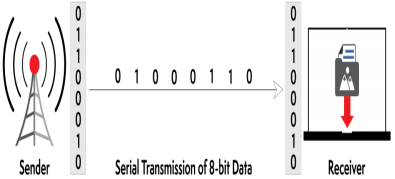
Example of Serial Data Transmission
Serial transmission has two classifications: asynchronous and synchronous.
Asynchronous Serial Transmission
Data bits can be sent at any point in time. Stop bits and start bits are used between data bytes to synchronize the transmitter and receiver and to ensure that the data is transmitted correctly. The time between sending and receiving data bits is not constant, so gaps are used to provide time between transmissions.
The advantage of using the asynchronous method is that no synchronization is required between the transmitter and receiver devices. It is also a more cost effective method. A disadvantage is that data transmission can be slower, but this is not always the case.
Synchronous Serial Transmission
Data bits are transmitted as a continuous stream in time with a master clock. The data transmitter and receiver both operate using a synchronized clock frequency; therefore, start bits, stop bits, and gaps are not used. This means that data moves faster and timing errors are less frequent because the transmitter and receiver time is synced. However, data accuracy is highly dependent on timing being synced correctly between devices. In comparison with asynchronous serial transmission, this method is usually more expensive.
When is serial transmission used to send data?
Serial transmission is normally used for long-distance data transfer. It is also used in cases where the amount of data being sent is relatively small. It ensures that data integrity is maintained as it transmits the data bits in a specific order, one after another. In this way, data bits are received in-sync with one another.
What is parallel transmission?
When data is sent using parallel data transmission, multiple data bits are transmitted over multiple channels at the same time. This means that data can be sent much faster than using serial transmission methods.
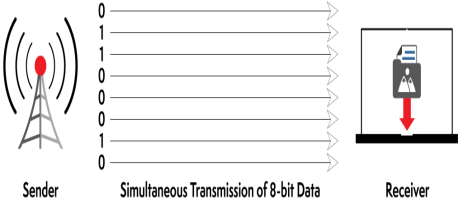
Example of Parallel Data Transmission
Given that multiple bits are sent over multiple channels at the same time, the order in which a bit string is received can depend on various conditions, such as proximity to the data source, user location, and bandwidth availability. Two examples of parallel interfaces can be seen below. In the first parallel interface, the data is sent and received in the correct order. In the second parallel interface, the data is sent in the correct order, but some bits were received faster than others.
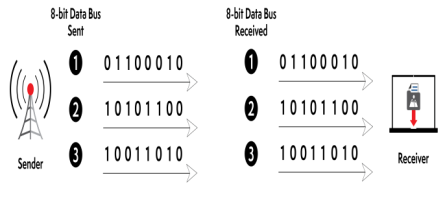
Example of Parallel Transmission – Data Received Correctly

Example of Parallel Transmission – Data Received Incorrectly
Advantages and Disadvantages of Using Parallel Data Transmission
The main advantages of parallel transmission over serial transmission are:
- It is easier to program;
- And data is sent faster.
Although parallel transmission can transfer data faster, it requires more transmission channels than serial transmission. This means that data bits can be out of sync, depending on transfer distance and how fast each bit loads. A simple of example of where this can be seen is with a voice over IP (VOIP) call when distortion or interference is noticeable. It can also be seen when there is skipping or interference on a video stream.
When is parallel transmission used to send data?
Parallel transmission is used when:
- a large amount of data is being sent;
- The data being sent is time-sensitive;
- And the data needs to be sent quickly.
A scenario where parallel transmission is used to send data is video streaming. When a video is streamed to a viewer, bits need to be received quickly to prevent a video pausing or buffering. Video streaming also requires the transmission of large volumes of data. The data being sent is also time-sensitive as slow data streams result in poor viewer experience.
Text Books:
1. Computer Basics by IGNOU.
2. Suresh K Basendrea: Computers Today
3. Pradeep K. Sinha, Priti Sinha, “Computer Fundamentals”. BPB Publications.
4. Rajaraman, V., “Fundamental of Computers”. Prentice Hall India, New Delhi
5. Sanders Donald H Computers Today